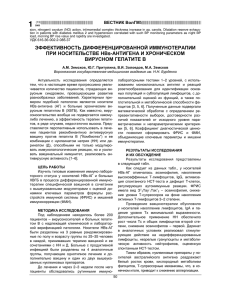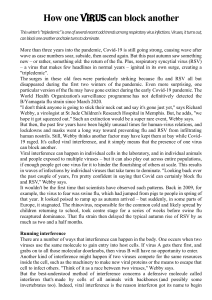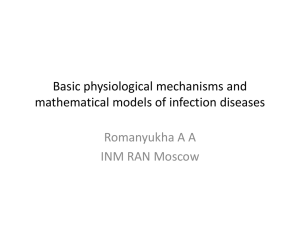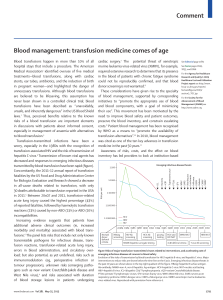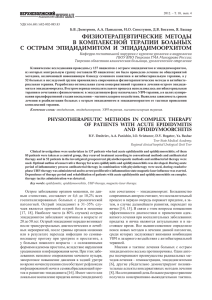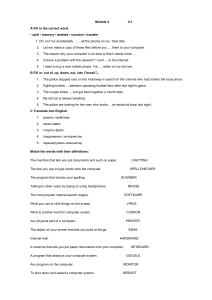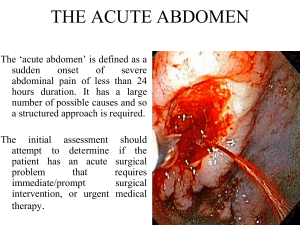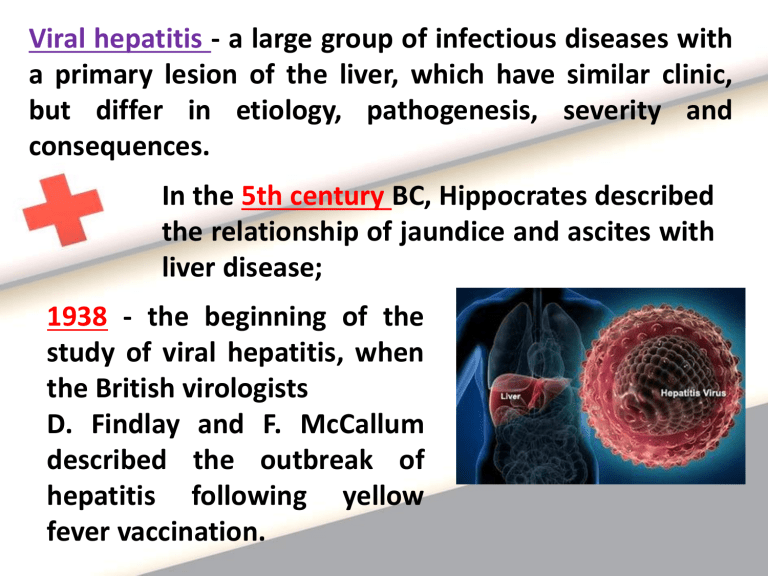
Viral hepatitis - a large group of infectious diseases with a primary lesion of the liver, which have similar clinic, but differ in etiology, pathogenesis, severity and consequences. In the 5th century BC, Hippocrates described the relationship of jaundice and ascites with liver disease; 1938 - the beginning of the study of viral hepatitis, when the British virologists D. Findlay and F. McCallum described the outbreak of hepatitis following yellow fever vaccination. Currently known 8 agents of viral hepatitis - Hepatitis A virus (HAV) – viral hepatitis A (VHA) - Hepatitis E virus (HEV) - viral hepatitis E (VHE) - Hepatitis B virus (HBV) - viral hepatitis B (VHB) - Hepatitis C virus (HCV) - viral hepatitis C (VHC) - Hepatitis D virus (HDV) - viral hepatitis D (VHD) The most dangerous for the population are VH with blood-contact and vertical transmission - B, C, D (because of the high probability of development of chronic forms (in HCV – the highest), liver cirrhosis and hepatocellular carcinoma. These effects lead to reduced life quality and significant economic loss. Pathomorphological changes of VH Mechanism of them is different: HAV, HCV, HDV - have a direct cytolytic effect; HBV – indirectly via the immune system. 1. 2. 3. 4. 5. Intoxication Syndrome of cytolysis of hepatocytes, Сholestasis syndrome, Hepato-cellular insufficiency, Mesenchymal-inflammatory syndrome Characteristic of pathogenic syndromes of VH LABORATORY CHARACTERISTIC PATHOGENESIS CLINICAL CHARACTERISTIC Intoxication Accumulation of toxic metabolites due to damage of hepatocytes and violation of their functions Hyperthermia (febrile or subfebrile), headache, dizziness, weakness, loss of appetite, nausea, vomiting, body aches, myalgia, arthralgia Syndrome of cytolysis of hepatocytes Local membrane damage of hepatocytes and infiltration into the bloodstream of the active intracellular (proteolytic) enzymes Hepatomegaly, weakness, Increased level hyperthermia of AlAT, AsAT, LDG SYNDROME Increased level of blood urea, creatinine Characteristic of pathogenic syndromes of VH SYNDROME PATHOGENESIS CLINICAL CHARACTERISTIC LABORATORY CHARACTERISTIC Cholestasissyndrome Dysfunction of excretion of bilirubin connecting with glucuronic acid (direct fraction) from hepatocytes to bile ducts Jaundice, itchy skin, darkening of urine, discoloration of feces Increased total bilirubin and violation of the ratio of direct and indirect fractions in the upward direct Mesenchymalinflammatory syndrome Proliferativeinfiltrative changes in the stroma of the liver Hepatomegaly, discomfort in the right hypochondrium Change of proteinsediment samples (thymol test) Characteristic of pathogenic syndromes of VH SYNDROME PATHOGENESIS Hepato-cellular Destruction of insufficiency hepatocytes, violation of their function CLINICAL CHARACTERISTIC LABORATORY CHARACTE-RISTIC Hemorrhagic syndrome (bleeding gums, at the site of injection, in severe form – nasal, uterine, intestinal bleeding, prolonged menstrual period), peripheral edema, ascites, anasarca - in severe failure Altered coagulation (decreased level of prothrombin, fibrinogen A and appearance of fibrinogen B), decreased total protein CLINICAL CLASSIFICATION B 15 Acute VHA: B 15.0 VHA with hepatic coma; B 15.9 VHA without hepatic coma; B 16 Acute VHB: B 16.0 Acute VHB with HDV (coinfection) with hepatic coma; B 16.1 Acute VHB with HDV (coinfection) without hepatic coma; B 16.2 Acute VHB without HDV with hepatic coma; B 16.9 Acute VHB without HDV without hepatic coma; B 17 Other acute VH: B 17.0 Acute HDV- superinfection in carrier of HBV; B 17.1 Acute VHC; B 17.2 Acute VHE; B 17.8 Other verified acute VH; B 17.9 Acute unverified VH; B 18 Chronic VH: B18.0 Chronic VHB with HDV; B 18.1 Chronic VHB without HDV; B 18.2 Chronic VHC; B 18.8 Other chronic VH; B 18.9 Chronic VH unverified B 19 Unverified VH: B 19.0 Unverified VH with hepatic coma; B 19.9 Unverified VH without hepatic coma CLINICAL CLASSIFICATION On the duration and cyclicity of course: a) Acute VH; b) Subacute or lingering VH; c) Recurrent VH; d) Fulminant VH; By severity: a) Mild form; b) Moderate form; c) Severe form; According to expression of clinic: a) Icteric form: - cytolytic (typical); - cholestatic; b) Unicteric form; c) Subclinical form; d) Obliterated form VIRAL HEPATITIS A -intestinal anthroponotic viral infection with fecal-oral mechanism of transmission, characterized by hepatonecrosis, clinicaly – by intoxication, hepatomegaly, sometimes jaundice. Etiology: 1. Hepatovirus, Picornaviridae; 2. Has a rounded shape, a single chain of RNA; 3. Stable in the environment (for items stored for about 1 month); 4. Not inactivated by stomach acid; 5. Sensitive for the ribavirin, amantadine; Epidemiology: 1. Fecal-oral mechanism of transmission: - watery route; - alimentary route; - contact way (through dirty hands, towels, linen, dishes); 2. Source: - patient in the incubation, prodromal period and climax of the disease; - with inapparant, obliterated and unicteric (more dangerous) forms; - after the appearance of jaundice the risk of infection is reduced; 3. Susceptibility: - general; - children (after the first year of life); - teenagers, young people to 35 years; - patients with immunosuppression; 4. Seasonality: summer-autumn; 5. Factors: contaminated water, infected food products, household items; 6. Epidemics occur every 4-7 years; 7. Repeated infection is not seen. Pathogenesis Damage of hepatocytes due to cell cytotoxic immune reactions and direct cytopathic effect of the virus. Main link of pathogenesis – is biochemical reaction – peroxide oxygenation of lipids, leading to destraction of hepatocyte phospholipids and increased membrane permeability. Phases: 1. Penetration of the virus into hepatocytes, 2. Reproduction leads to cytolysis and degeneration of cells. 3. Excrection: virus enters from the affected cells via bile in the intestine and excreted with feces. CLINICAL CHARACTERISTIC 1. Cyclical disease; 2. Incubation – asymptomatical, duration 10-50 days, but on an average 28 days; at watery and alimentary ways - is shorter, in contact – longer; 3. Initial period – duration 5-7 days: a) Intoxication: - hyperthermia till 38-39ºC; headache, weakness; b) Dyspepsia: - loss of appetite, nausea, vomiting, feeling of heaviness in the epigastrium and right hypochondrium; c) Change (darkening) in color of urine; Initial period of HAV may occur in 3 clinical variants: - flu-like: - hyperthermia, nasal congestion, discomfort in the oropharynx, coughing, - dispeptic: - anorexia, nausea, vomiting, stomach pain, diarrhea; - astheno-vegetative: - general weakness, irritability, indifference, insomnia or drowsiness CLINICAL CHARACTERISTIC 4. Climax (icteric) period: a) jaundice: - with its appearance patient's state is improved (additional diagnostic criteria), - first painted the mucosa of the oropharynx and the sclera, later - the skin of the trunk, and then extremities, - continues 2-3 weeks; - 3 phases: progression (3-4 days), peak (1-2 weeks) and attenuation (2 weeks); b) discolored stool, dark urine (dark brown, like root beer or black tea, foamy); c) enlarged liver and spleen (palpation is painful, dense liver tissue); d) cardiovascular sd: tendency to hypotension, bradycardia 5. Reconvalescence: a) continues 3-6 month; b) jaundice disappears gradually; c) asthenovegetative syndrome. LABORATORY CHARACTERISTIC Specific methods: 1. Method of isolation of virus - virological (detection of the virus in the feces during initial period), 2. PCR - within 1 week of the disease, 3. Serological confirmation - ELISA - revealing of anti-HAV IgM (determined in the acute period of the disease), the maximum titer in 2-3 months, persists for 2-6 months, anti- HAV IgG identified in the lifetime. Detection of anti-HAV IgM indicates the presence of a current acute infection; High titers of anti- HAV IgG confer immunity from re-infection and indicate the carried VHA Nonspecific methods: 1. CBC - leukopenia, neutropenia, relative lymphocytosis, normal ESR, 2.Biochemical test of blood: - increased transaminases (initial period and climax), especially ALT (a marker of cytolysis) - above normal in 3-4 times, reduced in reconvalescence, - hyperbilirubinemia due to direct fraction in icteric period (indicator of the severity of the disease), - increased alkaline phosphatase, LDG, - increased blood urea (sometimes in severe forms), - coagulogramm - no change, - urobilinogen - in urine Complex of clinical-anamnestic data of VHA: 1. Cyclical development, 2. Presence of prodromal (initial) period, 3.Sequence of development of intoxication, jaundice and hepatosplenomegaly, 4. Epidemiologic anamnesis: - contact with patients with VHA, - using of unboiled water, - unhygienic behaviour, 5. Laboratory data: - hyperbilirubinemia (direct fraction), - increased transaminases, - urobilinogen in urine, - markers – anti-HAV IgM Viral hepatitis B – mixed viral antroponotic infection from the group of transfusion hepatitis, characterized by lesions of hepatocytes and occurring in different clinical forms. Hepatitis B occurs in chronic, lingering and acute forms. - In 1963 B. Blumberg isolated from the blood of Australian aborigines special "Australian antigen", which is considered a marker of serum hepatitis. - D. Dane (1970) identified a new virus of hepatitis, justifying the existence of new nosological forms - viral hepatitis B. АСUTE VIRAL HEPATITIS B (VHB) F. Hepadnaviridae, G. Orthohepadnavirus. - spherical form (42 nm), - lipoprotein envelope (7 nm) (HBs Ag), -nucleocapsid (соre) (diameter 28 nm), -DNA, genome contains of S, C, X, P genes, - main viral proteins are encoded by genes S, pre-S1,pre-S2. -protein pre-S2 has specific receptors to albumin, which allocates on hepatocytes. -protein S1 – has the dominating antigenic site "a“ contributing specificity of the virus. All these proteins can be found in plasma during replication of viruses!!! • The gene C- encodes protein of a nucleocapsid HBcAg (it is only inside hepatocytes), but his soluble antigenic variety HBe Ag circulates in a blood and has 3 serovars • Gene Х - activator of all genes HBV, probably induces appearance of a hepatocell carcinoma (patients have the high level of anti-HBX) • The gene Р - occupies 80 % (-) chain DNA - encodes DNA-polymerase, transcriptase, ribonuclease • The surface antigene НBsAg (from 22 up to 700 nm) has 4 main subtypes (ayw, ayr, adw, adr) There are 3 virus-specific antigens: - Antigen of replication (HBeAg); - Core-antigen (HBcAg); - Surface-antigen (HBsAg) (Australian); Detection of circulating immune complexes in 3-4 months after the onset of the disease means presence the risk of chronization of the process. Favorable sign for prognosis of the disease is disappearance of the surface antigen and formation of antibodies to HBsAg, indicating a stop the viral replication 1.Stable in the environment, 2.Can be inactivated: - At room temperature - in 6 months - At 100º C- in 20 minutes - At 160º C (dry fever) - in 1 hour - At 120º С) - in 30 minutes - In plasma- in 25 years - In a refrigerator - in 6 months - At рН 2.4 - in 2 hours - In usual concentrations of disinfectant solutions – in 2 - 7 days!!! EPIDEMIOLODY: 33 % of the population have VHB; 350 - 400 millions of them are the carriers of HBsAg! (on Russia more then 1 million of carriers !) Source - human with acute and chronic hepatitis; - HBsAg-carrier. Groups of high risk: - Мedical workers, contacting with a blood - Recipients of biological tissues - Patients with often parenteral infusions - Mentally retarded and looking after staff - Patients with chronic diseases of a liver - Children birthing from the mothers – carrier of HBsAg - Drug addicts and prostitutes - Homosexuals and persons with HIV-infection - Inhabitants of hyperendemic by VHB regions In Russia– 188, 000 patients with chronic hepatitis and cirrhosis are annually registered and 6000 of them died!!! Frequency of revealing of markers of VHB: - Among medical workers 33.3 % - Among the patients with venereal diseases – 49.3 % - Among the donors of a blood 14.5 % - Among the population 3.8 % The mode of transmission – PARENTERAL Modes of transmission: - sexual (horizontal) - 51.9 % - intranatal and postnatal (vertical) - 1% - 10% - 50 % - transplacental - 6 - 10 % - hemopercutaneus (home contact ) - 6 - 10 % Artificial modes of transmission: - all medical manipulations with damage of skin and mucous - IV drug addicts , tattoo, cosmetic procedures Infection dose of blood in volume - 0,00004 - 0,000001 ml. Frequency of newborn infection - 0,02 - 40 % The risk of chronic HBsAg-carriage: - at newborn infection - 90 %, - 1-st year of life 50 %, - more than 1-st year 20 % - in adults 5 - 10 % One injection of blood with HBsAg - causes a disease in 90 % of cases. Hazard after one prick of infectious needle - 34 % In 50 % of cases the source of infection is not revealed! PATHOGENESIS 1. Fixation of the virus on surface of hepatocyte through protein pre- S2 via endocytosis; 2. "«Undressing" of the virus and beginning of 3. Replication: - the nucleocapsid is invade in core of hepatocyte, where due to viral DNA-polymerase the viral chain (+) is completed !! - synthesis of viral proteins; - formation of the external envelope with viral antigenes; Replication of virus is possible in cells of bone marrow, spleen, monocytes and lymphatic tissue. 4. Immune response - when immunity is depressed completely the disease does not develop!!! CLINICAL CHARACTERISTIC 1. Cyclical disease with expressed jundice; 2. Incubation – asymptomatical, duration 40-180 days, but on an average 60-90 days; - can be revealed increased ALT; 3. Initial period – duration till 2-3 weeks, starts gradually: a) Intoxication: - hyperthermia till 38-39ºC; headache, weakness; b) Dyspepsia: - loss of appetite, nausea, vomiting, feeling of heaviness in the epigastrium and right hypochondrium, meteorism; c) Change (darkening) in color of urine; d) Hepatomegaly (painful palpation); e) Coated tongue with white or grey fur; CLINICAL CHARACTERISTIC Initial period of HBV may occur in 3 clinical variants: - arthralgic (25-30%): - pain in joints, without external changes, sometimes redness, edema; - dispeptic: - anorexia, nausea, vomiting, stomach pain, diarrhea; - astheno-vegetative: - general weakness, irritability, indifference, insomnia or drowsiness, sweating, headache, dizziness FREQUENCY of SIGNS of INITIAL PERIOD - Lowering appetite - Weakness - Nausea - Heaviness in hypochondrium - Joint pain, muscle pain - Headache - Meteorism - Vomiting - Abdominal pain - Fever - Dermal itching - Diarrhea - Giddiness - Dermal eruption - 95,6 (in %) - 94,5 - 65,3 - 57,2 - 46,8 - 34 - 32,9 - 31,5 - 28,4 - 22,5 - 21,2 - 9,5 - 8,2 -8 CLINICAL CHARACTERISTIC 4. Climax (icteric) period: a) jaundice: - with its appearance patient's state is worsen (additional diagnostic criteria), - first painted the mucosa of the oropharynx and the sclera, later - the skin of the trunk, and then extremities, - continues 4-8 weeks; - 3 phases: progression (2-3 days), peak (2-3 weeks) and attenuation (2 weeks); b) discolored stool, dark urine (dark brown, like root beer or black tea, foamy); c) enlarged liver and spleen (palpation is painful, dense liver tissue); CLINICAL CHARACTERISTIC d) cardiovascular sd: tendency to hypotension, bradycardia; e) arthralgia disappears, but intoxication, dyspepsia and asthenia is increased; f) hemorrhagic changes: petechial exanthema, enantema, nasal bleeding , microhematuria or profuse bleeding in severe form; 5. Reconvalescence: a) recovery of liver functions and regeneration of tissue long-term (from 1-3 months to 1-2 years); b) jaundice disappears gradually; c) asthenovegetative syndrome. LABORATORY CHARACTERISTIC Specific methods: 1. Method of isolation of virus - virological (detection of the virus in the liver tissue) – biopsy; 2. PCR - within 1 week of the disease, 3. Serological confirmation - ELISA - revealing of HBsAg (in incubation); HBeAg (replication of virus); anti-HBcAg IgM (acute VHB), anti-HBcAg IgG (chronic VHB) the maximum titer in 2-4 weeks, persists for 2-6 months; Circulation of HBsAg within 7-8 weeks or HBeAg within 3-4 weeks from the onset of VHB indicates chronization; Diagnostic markers of viral hepatitis of various etiologies Nosology VHB Markers HBsAg Value Indicator of contact with HBV or its presence in the body (acute, chronic infection, "healthy carrier") HBeAg Indicator of active replication of virus, high infectivity of blood, high risk of vertical transmission of HBV HBcAg Indication of presence of virus in the body (determined only with a liver biopsy) Nosology Markers Value HBV DNA HBV Presence of the virus and its active replication Anti-HBs Ig Indicates past HBV or presence of postvaccinated immunity Anti-HBc IgM Index of active virus replication Anti-HBc IgG Indicates exposure to the virus in the past Anti-HBe Ig DNA-polimerase Indicates a possible completion of the replication indication of the presence of the virus and its active replication Nonspecific methods: 1. CBC – leukopenia or normocytosis, neutropenia, lymphocytosis, decreased platelets, increased ESR; 2.Biochemical test of blood: - increased transaminases (initial period and climax), ALT, AST (markers of cytolysis) - above normal in 3-4 times, reduced in reconvalescence, - hyperbilirubinemia due to direct fraction in icteric period (indicator of the severity of the disease), - increased significantly alkaline phosphatase, LDG, - increased blood urea (sometimes in severe forms), - coagulogramm - no change, - urobilinogen - in urine Diagnosis of VHB is based on a combination of factors: 1. Cyclical development, 2. Presence of prodromal (initial) period, 3. Sequence of development of severe intoxication, jaundice and hepatosplenomegaly, 4. Hemorrhagic sd; 5. Laboratory data: - hyperbilirubinemia (direct fraction), - increased transaminases, Aph, - urobilinogen in urine, - markers – HBsAg, HBeAg, anti-HBsAg IgM, anti-HBeAg IgM, anti-HBcAg IgM Diagnosis of VHB is based on a combination of factors: 6. Epidemiologic anamnesis: - blood transfusion, - surgical and dental treatment, tattooing, manicure, pedicure for the last 6-8 months, - unknown sexual contact, - intravenous drug use, - homosexuality, prostitution, - sexual contact with a carrier of HBsAg, - the mother carrier of HBsAg Principles of treatment of viral hepatitis 1. Purpose - reducing the physical, emotional and dietary stress; 2. Etiotropic antiviral therapy – is not assigned, only at tendency of chronization; 3. Obligatory hospitalization and isolation of the patient; 4. Basic therapy: 1. Diet №5, 2. Bed rest, Pathogenic therapy: 3. Desintoxication: a) Plentiful drink b) Enterosorbents, lactulose c) Intravenous solutions (5% p-p glucose) d) Antioxidants (tocopherol, ascorbic acid), e) Metabolites, f) Hepatoprotectors, 4. Symptomatic treatment: - antipyretics, antiemetics, antispasmodics, purgative drugs, 5. Dispensary observation within 6-12 month (VHA), 1-2 years (VHB) Hepatic coma - complication of severe and fulminant forms of VHB, VHB+D. Reason (Pathogenesis) 1. Liver destruction redistribution of ions in the hepatocytes; 2. Disturbance of inactivation of metabolites; 3. Accumulation of of ammonium in the blood with tropisity to the CNS; 4. Edema-swelling of the brain Clinical signs of a developing coma 1. Increase of jaundice with the rapid increasing of the level of bilirubinemia; 2. Appearance of nausea and vomiting; 3. Development of anorexia; 4. Inversion of sleep (insomnia); 5. Appearance of hemorrhage;
